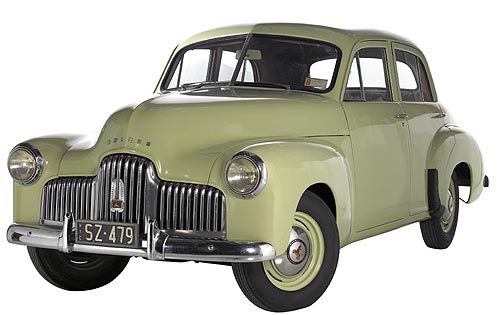James Alexander, Henry James and Edward
Wheewall Holden
James Alexander Holden arrived in SA in 1852, as a 17 year
old lad (b. 1 Apr 1835 Walsall STS) and started a leather
goods business in King William Street Adelaide in 1856.
James married Mary Elizabeth Phillips on 24 Sep 1857 at
her home. They had nine children: Edward Thos (d. 1858 age
3 mo), Henry Jas, Catherine Mary (d. 1862 age 2), Ellen
Elizabeth, Mary Winifred, Hubert Wm, Alexander Phillips
(d. 1870 age 1), Mabel Janette, and Charlotte Alice Lynette.
The company progressed from mainly saddlery work to coach
building and repairs. In 1885 Henry Adolphe Frost joined
as a junior partner and the company was later badged as
Holden & Frost Ltd. This was expanded into the production
of truck bodies, by Henry James Holden, after his father's
death on 2 Jun 1887 at Semaphore. Henry James married Mary
Ann Dixon Wheewall on 7 Apr 1881. They had five children:
Edward Wheewall, Ida Caroline Mary, Florence Muriel, Dorothy
Edith, and William Arthur.
IMPORTANT NOTICE
I hereby notify that I have this day SOLD the BUSINESS now
carried on by me as RETAIL SADDLER, as well as the FACTORY
with all its Tools and Material, situated in GRENFELL-STREET,
ADELAIDE, to my former Partners, Mr. H. A. FROST and Mr.
H. J. HOLDEN, and that after the first day of September
next I shall have ceased to have any interest in the said
Business. As my Son has so thoroughly studied the mechanism
and working of portable gas-making machines, I have transferred
to the New Firm my Agency, and I have Sold them all Muller's
Patent Automatic Gas Machines and Gasoline in stock or to
arrive.
I need hardly say how grateful I feel to my hundreds of
Customers who for nearly thirty years have given me their
patronage, as I am compelled by ill-health to give up active
business. In retiring I desire to inconvenience my friends
as little as possible, and although I must close my books
by the end of this month, I shall be glad to hear from any
customer if he desires longer credit, and try to arrange
accordingly.
JAMES A. HOLDEN. Adelaide. August 12, 1885.
South Australian Advertiser 15 Aug 1885 p2.
After the death of Frost in 1909, Henry Holden bought his
late partner’s shares. In 1913, they began producing
motorcycle sidecar bodies, and by the next year they were
producing custom car-bodies. Henry joined with Frederick
Hack in 1918 formed what was known as Holden Motor Body
Builders. The company was building bodies for Chevrolet,
Ford, Buick, Essex and Hupmobile by 1920 and was building
more than 500 bodies a month by 1922.
In 1924, Holden Motor Body Builders was contracted to build
entire car bodies for all General Motors chassis imported
into Australia. This deal ensured at least 10,000 units
per year would be produced.
Henry Holden died in 1926, leaving the company in the
hands of his son Edward Wheewall Holden (many online
biographies incorrectly report this man as b. 1896 when
in fact it was 14 Aug 1885) and the company was producing
36,000 units per year. Edward married Hilda May Lavis on
18 Mar 1908 and they had three children: Margaret Helen,
Nancy Ellen and John Jas.
General Motors set up headquarters in Melbourne, Victoria
and installed assembly plants in Adelaide, Brisbane, Melbourne,
Perth and Sydney. By 1927 over 100,000 units per year were
being sold. The 1930s Depression hit this American company
particularly hard with huge losses and a growing stockpile
of unsold cars. GM director, Graeme Howard, realised that
GM had no assets other than unsold cars, whereas Holdens
had assets including buildings, land and production equipment
to keep the company afloat through the hard times.
Graeme Howard and the now Sir Edward Holden agreed that
the merger of both companies would enable them to pool resources
and survive the low car sales. Vehicle prices were dropped
and by 1934 sales slowly but steadily increased. At this
time the company developed the famous Australian ute. (Technically
a coupe-utility—a car combined with a pickup bed originally
a Ford concept when a few units were built at Geelong from
1931!) When the second World War came about, the economic
recovery was complete. The new company, GM-H, concentrated
on building armaments engines and ships at Fishermen's Bend,
Melbourne. When the end of the war came about General Motors
Holden had already been considering plans for the first
all Australian car. The car would go under the name of Holden.
Designers had to design a car which could be used in Australian
environments. It had to have enough power and be able to
handle the harsh road and bush conditions. Australia's first
locally produced car (Model FX) rolled off the production
line on 29 November 1948. Unfortunately Sir Edward died
in 1947.
The price was set at £733, which represented two years
wages for the average worker at the time. Despite this,
the car was an immediate success and Holden could not satisfy
demand quickly enough. Eighteen thousand people had signed
up and paid their deposit without even having seen the vehicle.
|